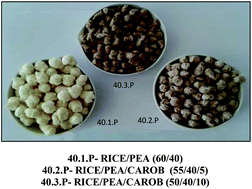The impact of extrusion on the nutritional composition, dietary fiber and in vitro digestibility of gluten-free snacks based on rice, pea and carob flour blends†
Abstract
Consumers and the food industry are demanding healthier products. Expanded snacks with a high nutritional value were developed from different rice, pea and carob flour blends. The proximate composition, starch (total and resistant), amylose and amylopectin, dietary fiber (soluble and insoluble) contents, and the in vitro protein digestibility of different rice-legume formulations, were evaluated before and after the extrusion process. Compared with the corresponding non-extruded blends (control), the extrusion treatment did not change the total protein content, however, it reduced the soluble protein (61–86%), the fat (69–92%) and the resistant starch contents (100%). The total starch content of all studied blends increased (2–19%) after extrusion. The processing increased the in vitro protein digestibility, reaching values around 88–95% after extrusion. Total dietary fiber was reduced around 30%, and the insoluble fraction was affected to a larger extent than the soluble fraction by the extrusion process. Because of its balanced nutritional composition, high dietary fiber content, as well as low energy density, these novel gluten-free snack-like foods could be considered as functional foods and a healthier alternative to commercially available gluten-containing or gluten-free and low nutritional value snacks.



 Please wait while we load your content...
Please wait while we load your content...